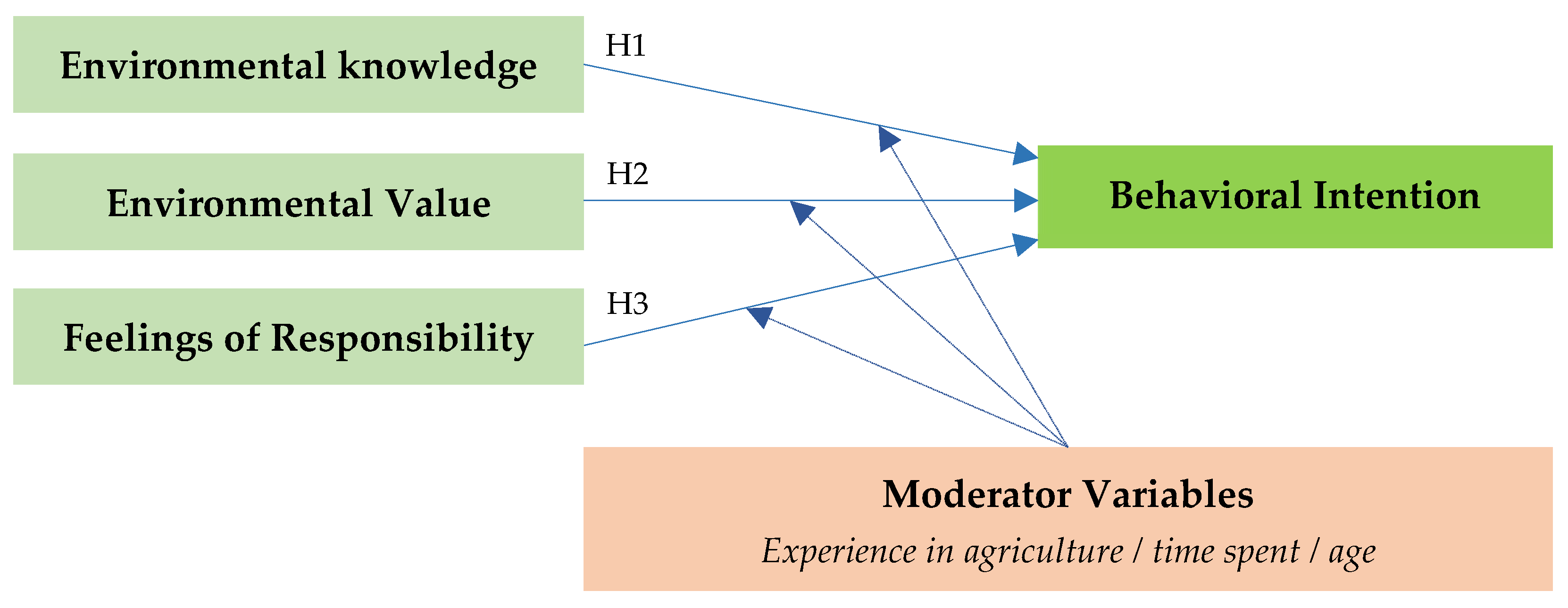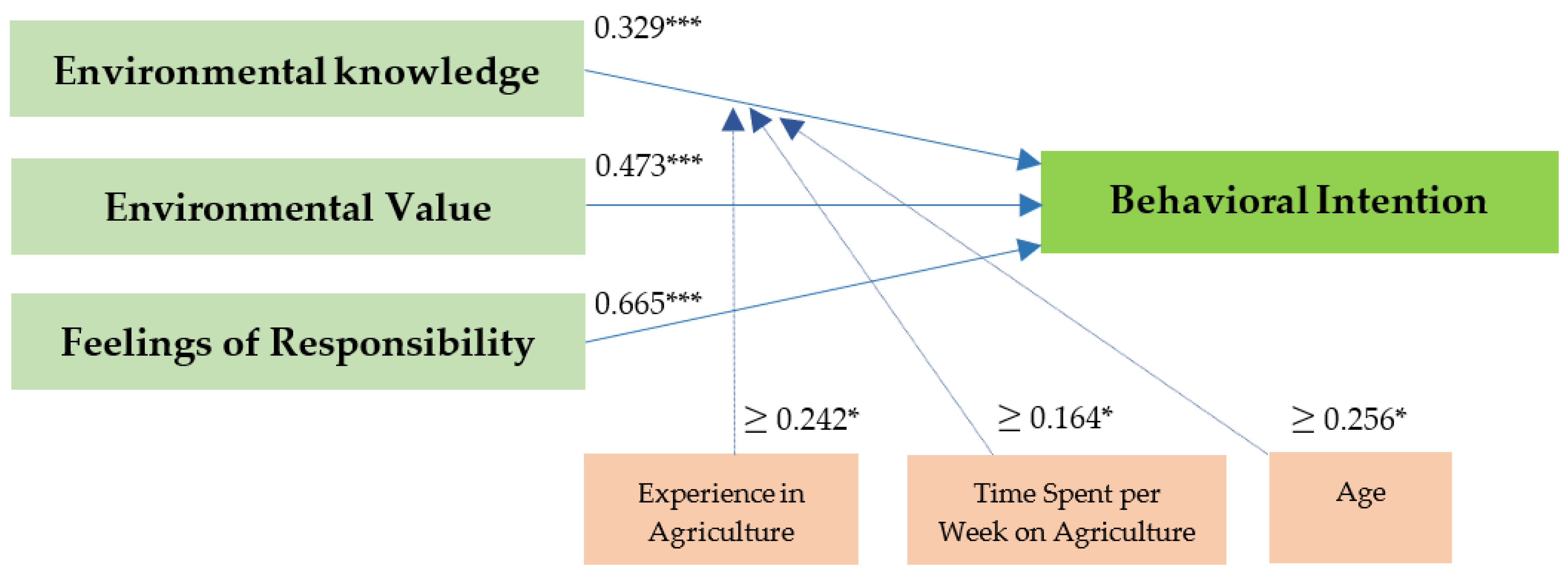Environmental Knowledge, Values, and Responsibilities Help to Enhance Organic Farming Intentions: A Case Study of Yunlin County, Taiwan
Abstract
1. Introduction
1.1. The Significance of Organic Agriculture for Environmental Sustainability
1.2. The Factors Influencing Farmers’ Adoption of Eco-Friendly Behaviors
1.3. Measuring Farmers’ Behavioral Intentions toward Organic Agriculture
2. Materials and Methods
2.1. Instruments
2.2. Research Locale and Participants
2.3. Sample Estimation and Sampling Method
2.4. Data Collection and Testing
3. Results
3.1. Descriptive Statistics
3.2. Description of the Study Model
3.3. The Influence of Moderator Variables on the Study Model
4. Discussion
5. Conclusions
Author Contributions
Funding
Institutional Review Board Statement
Data Availability Statement
Acknowledgments
Conflicts of Interest
References
- National Statistics Republic of China (Taiwan). Preliminary Findings of 2020 Agricultural, Forestry, Fishery and Husbandry Census. Available online: https://ws.dgbas.gov.tw/public/Data/dgbas04/bc1/2020census/2020census/%E5%88%9D%E6%AD%A5%E5%A0%B1%E5%91%8A/109%E5%B9%B4%E8%BE%B2%E6%99%AE%E5%88%9D%E5%A0%B1%E5%88%86%E6%9E%90_%E6%8F%90%E8%A6%81%E5%88%86%E6%9E%90.pdf (accessed on 20 June 2021).
- Paull, J. Attending the first organic agriculture course: Rudolf Steiner’s agriculture course at Koberwitz, 1924. Eur. J. Soc. Sci. 2011, 21, 64–70. [Google Scholar]
- Paull, J. Lord Northbourne, the man who invented organic farming, a biography. J. Org. Syst. 2014, 9, 31–53. [Google Scholar]
- Food and Agriculture Organization of the United Nations (FAO). FAQ. 1999. Available online: https://www.fao.org/organicag/oa-faq/oa-faq1/en (accessed on 23 February 2023).
- Wang, C.-H. The connotation and production techniques of organic agriculture. In Proceedings of the Symposium on Organic and Eco-Friendly Farming, Changhua County, Taiwan, 14 September 2018; pp. 107–123. [Google Scholar]
- Kiprutto, N.; Rotich, L.K.; Riungu, G.K. Agriculture, climate change and food security. Open Access Lib. J. 2015, 2, e1472. [Google Scholar] [CrossRef]
- Gomiero, T.; Pimentel, D.; Paoletti, M.G. Environmental impact of different agricultural management practices: Conventional vs. Organic agriculture. Crit. Rev. Plant Sci. 2011, 30, 95–124. [Google Scholar] [CrossRef]
- Stolze, M.; Piorr, A.; Häring, A.; Dabbert, S. The environmental impact of organic farming in Europe. In Organic Farming in Europe: Economics and Policy; University of Hohenheim: Stuttgart, Germany, 2000; Volume 6. [Google Scholar]
- Peyton, R.B.; Hungerford, H.R. An Assessment of Teachers’ Abilities to Identify, Teach, and Implement Environmental Action Skills; Southern Illinois University: Carbondale, IL, USA, 1977. [Google Scholar]
- Stern, P.C. New environmental theories: Toward a coherent theory of environmentally significant behavior. J. Soc. Issues 2000, 56, 407–424. [Google Scholar] [CrossRef]
- Hungerford, H.R.; Volk, T.L. Changing learner behavior through environmental education. J. Environ. Educ. 1990, 21, 8–21. [Google Scholar] [CrossRef]
- Best, H. Organic agriculture and the conventionalization hypothesis: A case study from West Germany. Agric. Hum. Values 2008, 25, 95–106. [Google Scholar] [CrossRef]
- Kings, D.; Ilbery, B. Organic and conventional farmers’ attitudes towards agricultural sustainability. In Organic Farming and Food Production; Konvalina, P., Ed.; IntechOpen: Rijeka, Croatia, 2012; pp. 121–144. [Google Scholar]
- Serebrennikov, D.; Thorne, F.; Kallas, Z.; McCarthy, S.N. Factors influencing adoption of sustainable farming practices in Europe: A systemic review of empirical literature. Sustainability 2020, 12, 9719. [Google Scholar] [CrossRef]
- Sapbamrer, R.; Thammachai, A. A systematic review of factors influencing farmers’ adoption of organic farming. Sustainability 2021, 13, 3842. [Google Scholar] [CrossRef]
- Stern, P.C.; Dietz, T.; Abel, T.; Guagnano, G.; Kalof, L. A value-belief-norm theory of support for social movements: The case of environmentalism. Hum. Ecol. Rev. 1999, 6, 81–97. [Google Scholar]
- Hines, J.M.; Hungerford, H.R.; Tomera, A.N. Analysis and synthesis of research on responsible environmental behavior: A meta-analysis. J. Environ. Educ. 1987, 18, 1–8. [Google Scholar] [CrossRef]
- Fishbein, M.; Ajzen, I. Belief, Attitude, Intention, and Behavior: An Introduction to Theory and Research; Addison-Wesley: Reading, MA, USA, 1980. [Google Scholar]
- Ajzen, I. The theory of planned behavior. Organ. Behav. Hum. Decis. Process 1991, 50, 179–211. [Google Scholar] [CrossRef]
- Kaiser, F.G.; Ranney, M.; Hartig, T.; Bowler, P.A. Ecological behavior, environmental attitude, and feelings of responsibility for the environment. Eur. Psychol. 1999, 4, 59–74. [Google Scholar] [CrossRef]
- Kaiser, F.G.; Hübner, G.; Bogner, F.X. Contrasting the Theory of planned behavior with the value-belief-norm model in explaining conservation behavior 1. J. Appl. Soc. Psychol. 2005, 35, 2150–2170. [Google Scholar] [CrossRef]
- Cronin, J.J.; Brady, M.K.; Hult, G.T.M. Assessing the effects of quality, value, and customer satisfaction on consumer behavioral intentions in service environments. J. Retail. 2000, 76, 193–218. [Google Scholar] [CrossRef]
- Lam, S.-P. Why are the observed correlations between environmental knowledge and environmental behavior so low? And how to increase them? J. Environ. Educ. Res. 2014, 10, 1–26. [Google Scholar]
- Kaiser, F.G.; Wölfing, S.; Fuhrer, U. Environmental attitude and ecological behaviour. J. Environ. Psychol. 1999, 19, 1–19. [Google Scholar] [CrossRef]
- Stern, P.C.; Dietz, T. The value basis of environmental concern. J. Soc. Issues 1994, 50, 65–84. [Google Scholar] [CrossRef]
- Schultz, P.W.; Zelezny, L. Values as predictors of environmental attitudes: Evidence for consistency across 14 countries. J. Environ. Psychol. 1999, 19, 255–265. [Google Scholar] [CrossRef]
- Hellison, D.; Wright, P. Assessment and Evaluation Strategies. Teaching Personal and Social Responsibility, 3rd ed.; Human Kinetics: Champaign, IL, USA, 2011; pp. 161–182. [Google Scholar]
- Venkatesh, V.; Morris, M.G.; Davis, G.B.; Davis, F.D. User acceptance of information technology: Toward a unified view. MIS Q. 2003, 27, 425–478. [Google Scholar] [CrossRef]
- Rather, R.A.; Hollebeek, L.D. Customers’ service-related engagement, experience, and behavioral intent: Moderating role of age. J. Retail. Consum. Serv. 2021, 60, 102453. [Google Scholar] [CrossRef]
- Molinillo, S.; Aguilar-Illescas, R.; Anaya-Sánchez, R.; Liébana-Cabanillas, F. Social commerce website design, perceived value and loyalty behavior intentions: The moderating roles of gender, age and frequency of use. J. Retail. Consum. Serv. 2021, 63, 102404. [Google Scholar] [CrossRef]
- Wang, L.H.; Yeh, S.S.; Chen, K.Y.; Huan, T.C. Tourists’ travel intention: Revisiting the TPB model with age and perceived risk as moderator and attitude as mediator. Tour. Rev. 2022, 77, 877–896. [Google Scholar] [CrossRef]
- Venkatesh, V.; Bala, H. Technology acceptance model 3 and a research agenda on interventions. Decis. Sci. 2008, 39, 273–315. [Google Scholar] [CrossRef]
- Cohen, J. Statistical Power Analysis for the Behavioral Sciences, 2nd ed.; Lawrence Erlbaum Associates: Hillsdale, NJ, USA, 1988. [Google Scholar]
- Li, M.N.F. Quality control for quantitative studies: Power and effect size analysis. J. Rea Elem. Second. Educ. 2002, 8, 1–24. [Google Scholar]
- Lin, C.-M. A study of influence on Hualien-Yilan indigenous farmers’ intention to adopt organic farming. J. Taiwan Indig. Stud. Assoc. 2016, 6, 101–133. [Google Scholar]
- Savari, M.; Sheheytavi, A.; Amghani, M.S. Promotion of adopting preventive behavioral intention toward biodiversity degradation among Iranian farmers. Glob. Ecol. Conserv. 2023, 43, e02450. [Google Scholar] [CrossRef]
- Savari, M.; Gharechaee, H. Application of the extended theory of planned behavior to predict Iranian farmers’ intention for safe use of chemical fertilizers. J. Clean. Prod. 2020, 263, 121512. [Google Scholar] [CrossRef]
- Tama, R.A.Z.; Ying, L.; Yu, M.; Hoque, M.M.; Adnan, K.M.M.; Sarker, S.A. Assessing farmers’ intention towards conservation agriculture by using the extended theory of planned behavior. J. Environ. Manag. 2021, 280, 111654. [Google Scholar] [CrossRef]
- Huang, S.M. The development of organic farming in Taiwan: A history of scientific paradigm shifts. Taiwan J. Anthropol. 2013, 11, 9–34. [Google Scholar]



| Construct | Item | Factor Loading | Goodness of Fit | Reliability and Validity |
|---|---|---|---|---|
| Environmental value | EV1 EV3 EV4 EV5 | 0.790 0.619 0.739 0.883 | 0.218 GFI = 0.999 AGFI = 0.993 RMR = 0.007 | Cronbach’s α = 0.918 AVE = 0.583 CR = 0.846 |
| Environmental knowledge | EK4 EK5 EK6 EK7 | 0.737 0.623 0.885 0.705 | 2.622 GFI = 0.982 AGFI = 0.911 RMR = 0.040 | Cronbach’s α = 0.823 AVE = 0.553 CR = 0.830 |
| Feelings of responsibility | RF1 RF2 RF3 RF4 RF5 RF6 | 0.604 0.646 0.751 0.816 0.953 0.909 | 4.819 GFI = 0.931 AGFI = 0.794 RMR = 0.058 | Cronbach’s α = 0.920 AVE = 0.624 CR = 0.907 |
| Behavioral intention | BI1 BI2 BI3 BI4 BI5 BI6 | 0.763 0.776 0.851 0.849 0.806 0.715 | 4.699 GFI = 0.934 AGFI = 0.803 RMR = 0.064 | Cronbach’s α = 0.918 AVE = 0.632 CR = 0.911 |
| Variable | Category | Percentage |
|---|---|---|
| Sex | Male | 72.4 |
| Female | 27.6 | |
| Education level | Elementary school | 8.6 |
| Junior high school | 15.1 | |
| Senior/Vocational high school | 36.8 | |
| University | 21.7 | |
| Graduate school and above | 17.8 | |
| Agriculture as main source of income | Yes | 40.8 |
| No | 59.2 | |
| Has participated in organic verification | Yes | 20.4 |
| No | 79.6 | |
| Has received organic certification | Yes | 17.1 |
| No | 82.9 | |
| Has participated in organic consultancy | Yes | 46.7 |
| No | 53.3 |
| Hypothesis | Standardized Regression Coefficient |
|---|---|
| H1: Environmental knowledge (EK) → Behavioral intention (BI) | 0.329 *** |
| H2: Environmental value (EV) → Behavioral intention (BI) | 0.473 *** |
| H3: Feelings of responsibility (FR) → Behavioral intention (BI) | 0.665 *** |
| Johnson–Neyman Significance Region | ||||
|---|---|---|---|---|
| Interaction | Value | % Below | % Above | Effect |
| EXP × EK | −1.315 | 9.333 | 90.667 | 0.242~ |
| EXP × EV | NS | |||
| EXP × RF | NS | |||
| Age × EK | −1.388 | 8.553 | 91.447 | 0.256~ |
| Age × EV | NS | |||
| Age × FR | NS | |||
| Time × EK | −0.909 | 15.789 | 84.211 | 0.164~ |
| Time × EV | NS | |||
| Time × FR | NS | |||
Disclaimer/Publisher’s Note: The statements, opinions and data contained in all publications are solely those of the individual author(s) and contributor(s) and not of MDPI and/or the editor(s). MDPI and/or the editor(s) disclaim responsibility for any injury to people or property resulting from any ideas, methods, instructions or products referred to in the content. |
© 2023 by the authors. Licensee MDPI, Basel, Switzerland. This article is an open access article distributed under the terms and conditions of the Creative Commons Attribution (CC BY) license (https://creativecommons.org/licenses/by/4.0/).
Share and Cite
Wang, P.-C.; Liu, F.-C.; Lee, D.-C.; Lin, M.-Y. Environmental Knowledge, Values, and Responsibilities Help to Enhance Organic Farming Intentions: A Case Study of Yunlin County, Taiwan. Agriculture 2023, 13, 1476. https://doi.org/10.3390/agriculture13081476
Wang P-C, Liu F-C, Lee D-C, Lin M-Y. Environmental Knowledge, Values, and Responsibilities Help to Enhance Organic Farming Intentions: A Case Study of Yunlin County, Taiwan. Agriculture. 2023; 13(8):1476. https://doi.org/10.3390/agriculture13081476
Chicago/Turabian StyleWang, Po-Ching, Fang-Chun Liu, De-Chih Lee, and Ming-Ying Lin. 2023. "Environmental Knowledge, Values, and Responsibilities Help to Enhance Organic Farming Intentions: A Case Study of Yunlin County, Taiwan" Agriculture 13, no. 8: 1476. https://doi.org/10.3390/agriculture13081476
APA StyleWang, P.-C., Liu, F.-C., Lee, D.-C., & Lin, M.-Y. (2023). Environmental Knowledge, Values, and Responsibilities Help to Enhance Organic Farming Intentions: A Case Study of Yunlin County, Taiwan. Agriculture, 13(8), 1476. https://doi.org/10.3390/agriculture13081476







